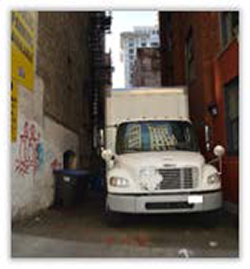United States - European Commission Urban Freight Twinning Initiative: Compendium of Project Summaries, Volume II
Overview of 2018-2019 International Urban Freight Roundtables
| Research | Metro Plans | Policy | United States |
Alley Inventory and Truck Occupancy Study
This research project, which is part of the Urban Freight Lab’s Final 50 Feet series, uses geographic information systems (GIS) to map the locations and features of all alleys in Seattle’s Center City, which includes downtown, uptown, South Lake Union, Capital, and First Hill urban centers. The Seattle Department of Transportation (SDOT) had curb data layers and acquired GIS data on all private truck loading bays and docks in an earlier Final 50 Feet project, but it lacked information on the city’s alleys needed to build a comprehensive truck load/unload space network. This research also includes a truck occupancy study in select alleys. Seattle is one of many major U.S. cities that have alley networks. Alleys are a critical part of the truck infrastructure network in cities as they primarily function as truck-only load/unload areas and throughways. In addition to Seattle, major cities with alley networks include Chicago, Denver, Detroit, and Minneapolis.

Freight truck parked in a Seattle alley.
Source: Urban Freight Lab University of Washington, 2017.
Project Types
Research, Metropolitan Plans, Policy.
Period of Performance
December 2017 - July 2018.
Project Site
Seattle, Washington, USA.
Contact
Barb Ivanov
Director, Urban Freight Lab
SCTL Center, University of Washington
Seattle, WA, USA
IvanovB@uw.edu
Topics Addressed
- Building/road design.
- Curbside delivery and parking.
- Economic competitiveness.
- Land use interactions.
- Last mile delivery.
Key Outcomes
The Urban Freight Lab (UFL) alley infrastructure survey has geocoded the alley locations and measured the narrowest points and turn radii of the entrance aprons, and other truck-related features of the city’s alleys so the city knows the maximum-size vehicles (waste pick up, delivery, and emergency vehicles) that can park in and/or pass through them. It has categorized alleys by truck usage and design characteristics. A forthcoming report on the alley truck occupancy study will provide a deeper understanding of how trucks use alleys in dense cities in context with curb space parking and private truck loading bays and docks to serve city businesses, workers, and residents. Key findings from the study include:
- Over 90% of all alleys in Center City are only one lane wide, and therefore, one parked vehicle blocks the entire alley.
- Vehicles parked in alleys were studied with 68 percent there for less than 15 minutes and 87 percent parked 30 minutes or less. The vast majority of cars and trucks load/unload quickly in alleys.
Stakeholder Involvement
SDOT is funding this research, set the parameters of the project, and may use the information to support development of data-based Alley Management Plans and policies. Urban Freight Lab (UFL) researchers designed the research plan and implemented it in 2018. Delivery firms who are members of the Urban Freight Lab (United Parcel Service and United States Postal Service) provided technical insights into the business case for promising strategies based on this analysis that may be pilot tested in the future.